My Nixie Gear
Last Update: 11.08.2005
|
Shack-Attack:
- DMM Nordmende Divo 3354-1 Series 1
- DMM Nordmende Divo 3354-1 Series 2
- DMM Rohde & Schwarz DIGIVOLT 05
- DMM Fluke 8100A
- DMM Marconi TF 2671
- DMM Keithley 160 DMM (x 2)
- DMM Russian B7-22A
- DMM DANA Model 5330 with Module 700
- DMM Schneider DIG.500
- DMM DANA 3800A
- CNT Levell TM51C Counter
- CNT HG Electronic Power Supply And Counter
- CALC Russian ISKRA-111 Desktop Calculator
- DPM Hartmann & Braun S2000 Panel-Meter
- FUN NixieMan Mk.1
|
|
Nordmende DIVO 3354/1 Series 1 |
This is the silver version from Series 1, S/N 1201, which had the BNC input and was intended for professional use. All chips and caps have 1969 or 1970 datecodes (7007 is latest), so it must have been made in around 1970. Few people back then could afford to buy a unit like that for private purposes anyway.
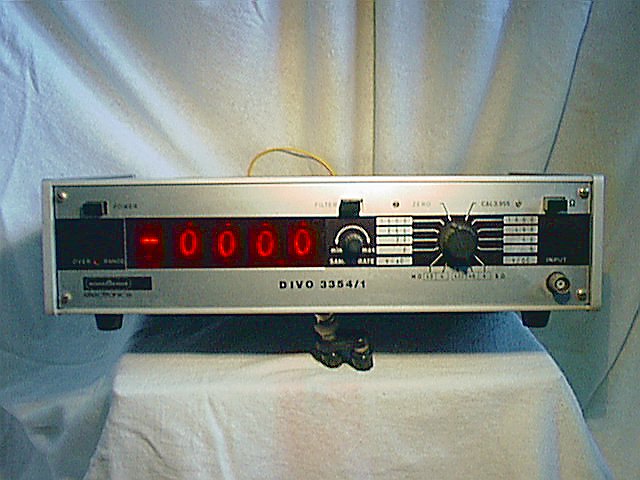 I bought this one as 'defective and without matching AC cable' but with 'BNC-to-Banana' converter from off Ebay in 2002 for less than 20 Euro. When I got it one of the soldered ZM1000 Nixies has the glass broken off closely above the pins and I had to replace it. The unit is mainly operational and does fine in most ranges, but the -3.955V reference is not properly displayed. Most likely a problem with the range switch.
I bought this one as 'defective and without matching AC cable' but with 'BNC-to-Banana' converter from off Ebay in 2002 for less than 20 Euro. When I got it one of the soldered ZM1000 Nixies has the glass broken off closely above the pins and I had to replace it. The unit is mainly operational and does fine in most ranges, but the -3.955V reference is not properly displayed. Most likely a problem with the range switch.
The instrument is built as a cartridge and can be pulled out of the instrument case after loosening a single screw at the rear. It has no case / GND separation and only a 2-wire AC input without GND wire of uncommon format. I didn't manage to get an appropriate AC cable for it yet.
 Back Up Back Up
|
|
Nordmende DIVO 3354/1 Series 2 |
This is the black and silver version from Series 2, S/N 1568, which had the 'banana-jack' input along with a GND / case separation switch at the rear.The datecodes on the chips inside are in the 1969 - 1970 range (7044 latest), so it must have been made in around late 1970 / early 1971. It already uses the standard IEC 3-pin AC socket.
 That unit also came from off german Ebay for about 30 DM (15 Euro) and was claimed operational but de-adjusted. After some minor adjustments it was ready to use and accompanied me through building my "Cookiebox" Amplifier for instance.
That unit also came from off german Ebay for about 30 DM (15 Euro) and was claimed operational but de-adjusted. After some minor adjustments it was ready to use and accompanied me through building my "Cookiebox" Amplifier for instance.
Unlike than on the Series 1 meter the Ohm 'test' button does not lock. This is explicitely mentioned a feature (not a bug) in the manual to avoid overheating / overloading of the resistance testing circuitry.
The display on both Nordmende DIVO 3354's is full 4 digit (4 x ZM1000) with a 0.000 - 3.999 range. There is an additional "special character" nixie (ZM1139), which displays the Ohm-symbol, "~","+" and "-" signs. A blinking "Over Range" neon is located left from the display.
The adjustments for Zero ("0000" display) and the Calibration ("- 3.955V" display) can be easily accessed on the unit front.
Ranges are 2 / 20 / 200 / 1000 VAC, 4 / 40 / 400 / 1000 VDC and 4 / 40 / 400 KOhm / 4 / 40 Mega Ohm. A filter to remove DC offset from AC is switchable too.
Here is the german version of the users / repair manual along with the diagrams for the DIVO 3354, Published in May 1970.
 Back Up Back Up
|
|
Fluke 8100A |
Another big name in the community: Fluke.
I had been working with Fluke DMMs like the famous Mod. 77 (Series 1) since the mid-80s, so I got used to their quality and precision. When this one showed up at german Ebay I immediately bid on it. And won it for a reasonable price.
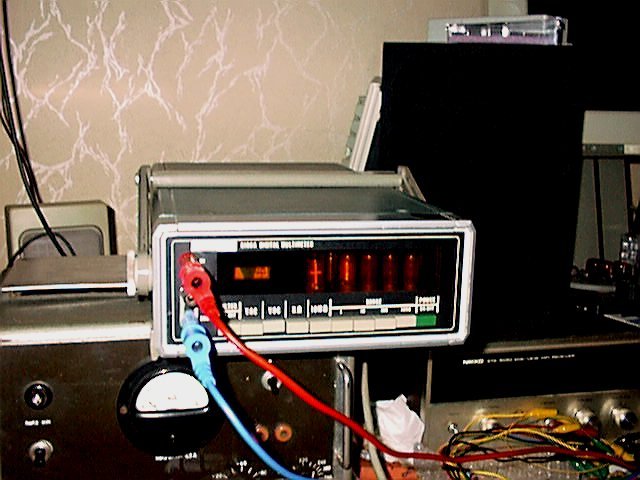 This unit, S/N 1520, arrived here in dusty but working condition. The only downside was the unfamiliar early Fluke AC connector to which none of the power cables seemed to fit. The opening in the rear of the case however nicely 'adopted' an IEC 3-pin connector and I was able to use one of my computer AC-cables. From then on the 8100A was a good and much-used companion on my workbench.
This unit, S/N 1520, arrived here in dusty but working condition. The only downside was the unfamiliar early Fluke AC connector to which none of the power cables seemed to fit. The opening in the rear of the case however nicely 'adopted' an IEC 3-pin connector and I was able to use one of my computer AC-cables. From then on the 8100A was a good and much-used companion on my workbench.
Up to a fateful day when I tested around with transformers. I forgot to detach the 8100A before detaching the power to the transformer - and the switch-off peak obviously shot the unit. It shows only erratical numbers, as if it got stuck during multiplexing. In the meantime a helpful friend from the NEONIXIES-L community at Yahoo helped me out with a circuit diagram, but it seems as if there were several of the MOSFET transistors shot (2N5459 ... anyone in for some of these ?) -Or- the Motorola MC839P / MC862P chips.
Practically it is dead - but I won't part from it that fast. Maybe I find another meter for parts ... ?
In case anyone needs the schematics:
- Page 1 - Left Side
- Page 1 - Right Side
- Page 2 - Left Side
- Page 2 - Rightt Side
- Page 3 - Entire Page
- Page 4 - Left Side
- Page 4 - Right Side
Valid for serial numbers 123 - 3409 and 3420 - 4097
Does not contain chip- and semiconductor designations.
Source: David Forbes, Tucson, AZ
http://www.cathodecorner.com/
A thousand thanks - even though I couldn't get it up again ... yet !
News: I happened to get a second 8100a unit on Ebay for a reasonable price.
I has been converted to the Euro AC plug already and works perfectly.
 Back Up Back Up
|
|
Marconi TF 2671 / Keithley 160 DMM (x 2) |
The first on top was sold on Ebay as defective and with no matching power cord. It is a Marconi Instruments Ltd. (UK) 'Digital Multimeter TF 2671', Serial Number 1928. When it came here it has another 3-pin connector at the rear, a round one this time, to which nothing really fit. Has been replaced with a fixed, non-detachable cable so far. It runs on 230V AC and 11 - 18V DC battery power. AC / DC and power switches are at the rear as well as the 5-pin DIN socket for the DC supply.
The unit suffered on some bad caps, a lot of dirt inside and a shot anode switch transistor, which has been replaced by a MPS-A42. Unit works now, may need some calibration and Nixie on LSB comes on a bit late.
The display is 3 1/2 digits (3 x ST-5870 / ZM1332K style tubes) with a long neon for the first digit, two neon bulbs show the "+" and "-" signs in a masked display front.
Ranges are 0.2 / 2 / 20 / 200 / 2000 V, mA and KOhm (up to 1000 V AC or DC only). The 1 KV uses an extra input terminal.
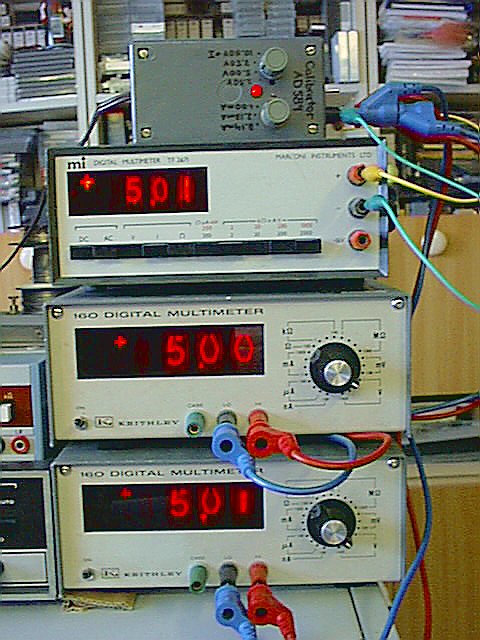 The two lower ones are both from Keithley Instruments GmbH (Munich / Germany) made '160 Digital Multimeter', the upper one is S/N 1-12989, the lower one is S/N 1-14024. They differ by the BCD Output option that the lower one hasn't got. Other than that they are alike. The range switch knob on the upper one is pretty loose and while the switch has a teflon axis it hasn't got enough grip to properly hold on it. In addition it suffers on a slightly weak high voltage for the Nixies, which exceeds 140 VDC earliest after 5 minutes. Haven't checked it in detail - I just let it 'warm up' and then it works fine.
The two lower ones are both from Keithley Instruments GmbH (Munich / Germany) made '160 Digital Multimeter', the upper one is S/N 1-12989, the lower one is S/N 1-14024. They differ by the BCD Output option that the lower one hasn't got. Other than that they are alike. The range switch knob on the upper one is pretty loose and while the switch has a teflon axis it hasn't got enough grip to properly hold on it. In addition it suffers on a slightly weak high voltage for the Nixies, which exceeds 140 VDC earliest after 5 minutes. Haven't checked it in detail - I just let it 'warm up' and then it works fine.
Both units have a green "Case" connector and can be operated with or without connection between input GND and case. The Ranges are 100 nA - 1000 mA (8 ranges), 100 Ohm to 1000 Mega-Ohm (8 ranges) and 1 mVDC - 1000 VDC (7 ranges), all in decade steps. The 160 cannot measure AC.
The display is 3 1/2 digit with a long neon bulb for the leading "1". Two further smaller neon bulbs in the masked front show the "+" and "-" signs.
That little box above the three DMM's is my homemade AD584 Calibrator, which puts out 2.50, 5.00, 7.50 and 10.00 Volt. Simple unit from the principle and with sufficient precision to get some meters adjusted. The circuit is shown here - and it is really simple. Allowes also current measuring.
 Back Up Back Up
|
|
Russian B7-22A DMM |
Another Ebay orphan: claimed generally functional with minor defect (running display) but with original wooden (lightblue painted) carrying case, german translated documentation, two probes (generally unuseable - particularly the high voltage probe cable is that stiff, that you are afraid to wipe the instrument from off the table), fuses and non-detachable power cable. Bought it for 21.20 Euro plus packing and mail. Turned out to be real bargain.
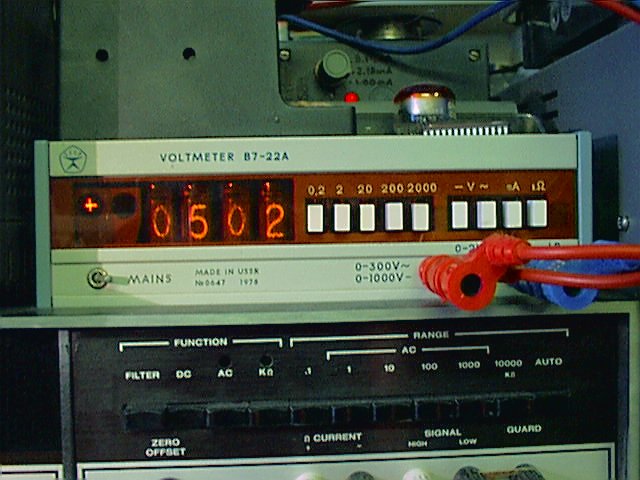 The unit with serial number No. 0647 and mfg. date 1978 (!!) is obviously of military / scientifical origin. You'll never forget the typical smell of a russian-made unit with its plastic accessories and booklet in the original wooden factory carrying case ... !
The unit with serial number No. 0647 and mfg. date 1978 (!!) is obviously of military / scientifical origin. You'll never forget the typical smell of a russian-made unit with its plastic accessories and booklet in the original wooden factory carrying case ... !
After breaking the wax-sealed case screws open the unit came apart quite nicely. The boards inside are sub-consumer-grade hardpaper types, though silver plated and wax-coated !! Truely unbelieveable that they really sold this sort of stuff - but they did. The problem with the DMM were a lot cold solder spots, which I'd removed in a two-hour session. The unit returned to normal, stable operation afterwards. Still a bit 'out of tune', but I have the Original Factory Manuals
(To be supplied later - Sorry !)
The display consists out of 4 unmarked IN-?? tubes of about the size of the ZM1332 / ST-5870 - maybe a tad higher - and they are not using the typical russian "Upside-down 2" for the "5" digit (as can be seen in the picture). Manual states they are IN-16 tubes.
The display is multiplexed at a low rate and shows visible flicker. Two neon bulbs to the left for "+" and "-" accompany the display. The Nixies have large getter pills above the character assembly. Each is of about 5 mm diameter and fixed with a 1mm thick wire "inverse-U" shaped left to right in the tube top. The tubes appear to have LH and RH decimal point, from which only the LH is used for that display.
Measuring ranges from 0.2 / 2 / 20 / 200 / 2000 Volt, mA and Ohm, up to 300 VAC and 1000 VDC only. The 0 - 2 V (DC and AC) has an extra input as well as the current and resistance (marked I,R - rightmost). The "Normal" voltage input is marked "0 - 300 V~ / 0 - 1000 V-" (leftmost).
There is a round fuse holder and a case-GND binding post at the rear and a "sort of" BCD-output at the unit underside.
In the meantime I got a second B7-22A unit from off german Ebay. The case is beige / lightgrey instead of beige / lightblue, the front is a little different, it has a way much darker plexiglass filter, the lettering is blue instead of black / blue and -finally- the writing is in German, not English. The unit serial number is 0409 and it has a Manufacturing date of 1979.
Additional Pictures:
Picture #2 The two uneven twins on the desk. Both powered ... really.
Picture #3 Lettering and display on the newer unit.
Picture #4 Lettering and display on the older unit.
Picture #5 Lettering and switches on newer unit. Didn't change.
Picture #6 The unit unpacked: power supply left, A/D converter above, display driver below.
Picture #7 Rather unfamiliar looking components to westeners eyes.
Picture #8 Same in the power supply. Note the upside-down installed power transistor.
Picture #9 Consumer-grade printboards, wax-coated. More upside-down mounted transistors.
Picture #10 Military-grade transformer, sheetmetal core, entirely drenched in laquer.
Picture #11 IN-16 Nixie detail. Massive overhead "Pill" - arguable if it is a getter or not.
 Back Up Back Up
|
|
DANA Model 5330 with Module 700 |
And yet another big name in the community: Dana.
Sorry for the poor picture, need to take a better one recently under better conditions.
I bought the Dana also from Ebay and I originally had the idea it could replace the shot Fluke ... but a) it is pretty big, b) has separate inputs for DC and Ohm and c) has no AC range.
Other than that it is outstanding 70th-technology. 6 digits display, mechanical relays for the Auto-ranging ... you hear it working.
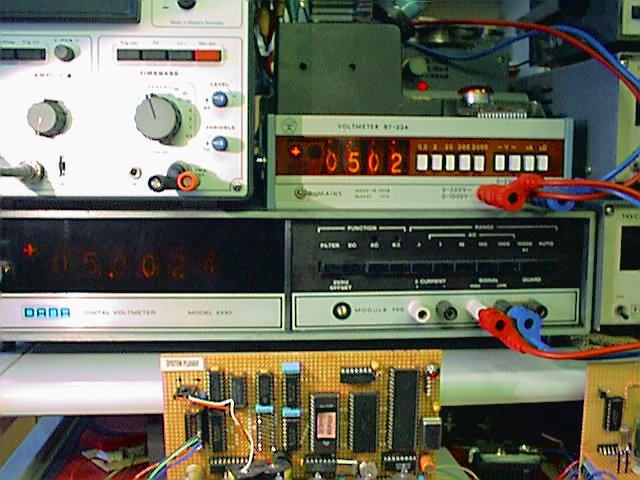 The power switch is combined with a "Hold" feature that freezes the display. That now consists out of 6 ZM1000 Nixies, accompanied by two neon lamps behind a mask for the signs.
The power switch is combined with a "Hold" feature that freezes the display. That now consists out of 6 ZM1000 Nixies, accompanied by two neon lamps behind a mask for the signs.
The "Module 700" seems to be the smallest in the range - and even that has markings for AC measuring, but the "plug in module" is missing and the "AC" switch on the front is a dummy only.
The ranges are 0.1 / 1 / 10 / 100 / 1000 / 10000 KOhm, up to 1.000 VDC only. The right-most button is "Auto Range".
To measure resistance you'll have to rig up the "Ohm current output" Minus to "Signal Low" input and current Plus output to the resistor and from there back to the "Signal High" terminal. Ooof. Antique method. I use the Dana for voltage measuring only.
The analog input section however seems to be thermically uncompensated. The instrument has a large drift over the first 10 minutes. I use to power it on, leave it running for at least 15 minutes ... then tune the "Zero Offset" at the front to the plus-minus sign transition at an all-zero display with a shortened input - then start the measuring.
With that the accuracy is outstanding: +/- 1 digit in the LSB. At 10.00 V input the display switches between 09.9999 and 10.0000 or 10.0001 only. And I think that's not too bad for an instrument that operates with a 'Single Slope' and had been made in the mid-70's.
 Back Up Back Up
|
|
Schneider DIG.500 |
You'd guessed it: I got it on Ebay in Germany
This now is a french Schneider Electronique DIG.500 "Handheld" DMM. Serial Number is 26710. Another one with an odd, non-standard AC input, but at least it can be powered from off 12V DC @ about 1 Ampere.
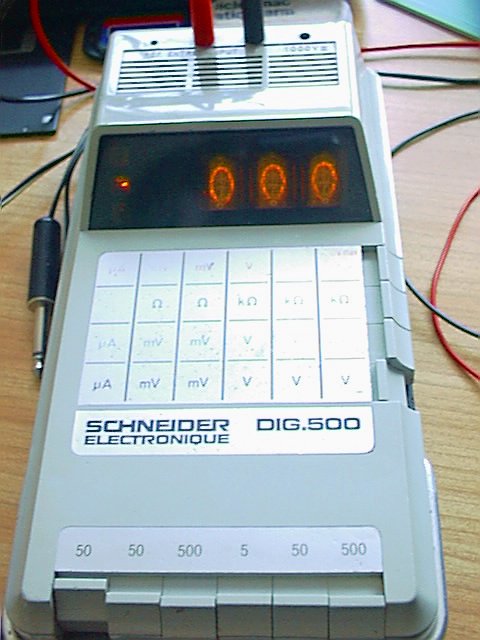 The unit features a 3-digit display of Thomson CSF "Made in France" TAF1317A 13-pin Nixies (7th pin up front = numeral "6", tube appears similar to ZM1080), 13mm character height, two decimal points. Remarkable on these Nixies is the overhead mercury reservoir. It has the usual X-Y ranging typical for handheld DMM's of that time with a row of vertical and horizontal buttons. The order is really odd - you get to get used to it.
The unit features a 3-digit display of Thomson CSF "Made in France" TAF1317A 13-pin Nixies (7th pin up front = numeral "6", tube appears similar to ZM1080), 13mm character height, two decimal points. Remarkable on these Nixies is the overhead mercury reservoir. It has the usual X-Y ranging typical for handheld DMM's of that time with a row of vertical and horizontal buttons. The order is really odd - you get to get used to it.
At the top it has 4 "holes". Leftmost is the "Reference" output, next to the right the "Normal" input for all ranges, except 1.000 VDC (up to 420 VAC only), which is the rightmost. The one left over is GND then.
Three neon indicators are located left from the display: "Arrow Up" (which substitutes the half "1" digit), "+ / -" that comes on, when the tested voltage is negative and "OL", which is Overload.
Inside the unit sports a pretty big transformer (under and behind the dsiplay) and some heatsinks for transistors. And a lot small signal transistors and diodes, few Op-Amps. I'm going to open it up again soon and take pictures from the inards. Whew. "Handheld" is a relative expression. It may weigh about 3 pounds - and I would say the attribute "portable" fits way better.
Additional Pictures:
Picture #2 Unit opened. No digital chips, only single transistors and OpAmps.
Picture #3 Nixie detail. Note the position of the mercury reservoir in the top.
 Back Up Back Up
|
|
DANA 3800A |
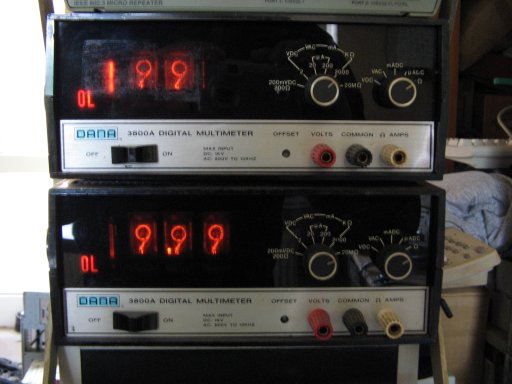 Well - as usual: Ebay orphans.
Well - as usual: Ebay orphans.
Two DANA 3800A DVMs. The lower one (S/N 504061) is fully functional, apart from a slightly weak "1" MSB neon. The upper one (S/N 504084) has a defective LSB Nixie. I have taken them apart for inspection but hadn't done anything yet. No time.
They measure VAC, VDC, mADC, µADC and the ranging goes 200 Ohm - 20MOhm and 200 mV - 200V DC / AC. Different inputs for volt and resistance.
 Back Up Back Up
|
|
Levell TM51C Counter |
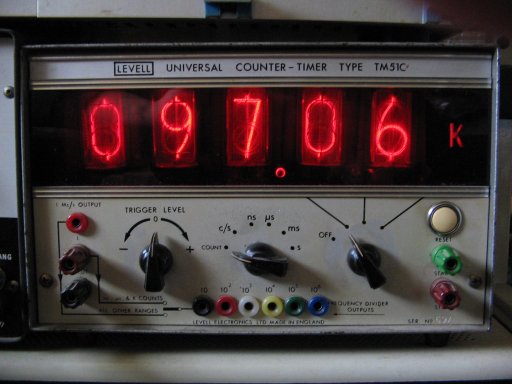 I bought it, since I found that I would need an antique counter.
I bought it, since I found that I would need an antique counter.
It is one of these early transistorized counters and it includes not one single IC, but a hell of Germanium transistors and diodes. Everything is done with discrete transistor stages.
The display consists out of 5 Ericsson GR10JF, similar to the ZM1040 with about 30 mm character height but with different and unusual pinout. I think they are OEM'd Hivac tubes originally. The decimal points are small neon bulbs.
It is capable to measure pulses, cycles per second and timings in ns, µs, ms and s. The counter-stages are fed to the frontpanel any you could use them as a pre-scaler for the input signal.
I happen to get a "manual" consisting out of a dozen pages of poor, photocopied quality but these include parts lists and schematics.
 Back Up Back Up
|
|
HG Electronic PS9 + FZ35 |
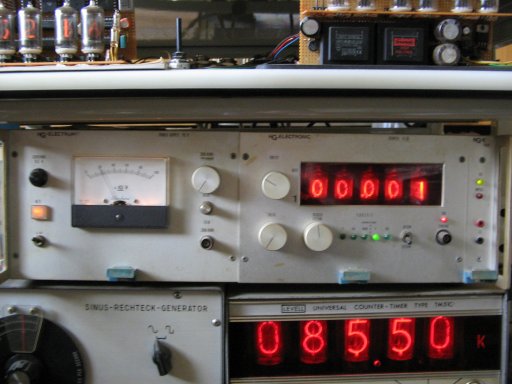 It's from Ebay of course.
It's from Ebay of course.
In the very beginning, when I started over again with Nixies I thought it were a good idea to have a regulated HV supply.
Then this unit came across my way. It is a regulated and adjustable 200 - 450V supply ... at lousy 100µA - intended for a Geiger-Mueller counting tube.
The FZ35 counter is fully TTL-based and has 5x ZM1000 nixies along with some neons and LEDs for signalling the operating mode.
Power supply and frequency counter are fed from a common power supply but otherwise independent units.
 Back Up Back Up
|
|
Russian ISKRA-111 Desktop Calculator |
As seen on Ebay - need I say more ?
To demonstrate the russian calculator technology of the mid-70's - here comes "ISKRA-111" !
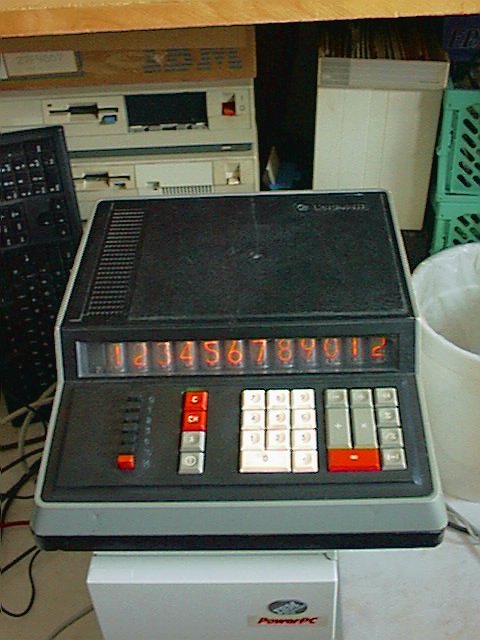 According to the keyplate the machine with the Serial No. 64732 is dated 1977. So it nicely stands in the row along with the B7-22A DMM further above.
According to the keyplate the machine with the Serial No. 64732 is dated 1977. So it nicely stands in the row along with the B7-22A DMM further above.
It even shares the same cheesy printboards with it. And some of the most odd-looking chips and transistors I'd ever seen.
The ISKRA (Iskra = "Spark") now Has the typical russian Nixies with the "upside-down 2" for the "5" digit.
Its display is 12 digits and some Nixies start operating far later than the others after power on. You'd either give it a gentle whack or wait some 5 minutes until everything has stabilized.
There is a website on the net, Museum of Soviet Calculators, that deals with the different russian calculators and the various ISKRA models, from which the one with an ultrasonic delay line for result-storing might be the most odd. This 111-model already uses semiconductor storage ...
 Back Up Back Up
|
|
Hartmann & Braun S2000 Panel-Meter |
Not really a Nixie device - but close enough.
That Hartmann & Braun (H&B) S2000 unit was 'Kings Class' - one of the 'Rolls-Royce' of the panelmeters back in the early 70's. I don't really want to know what customers had to pay for one of these units.
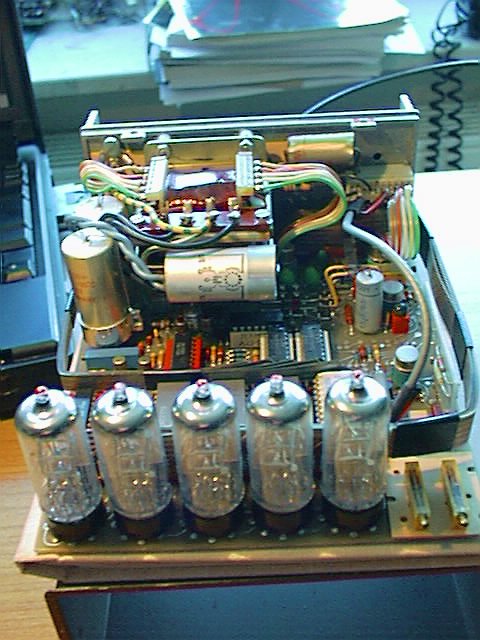 The display consists out of 5 Tung-Sol DIGIVAC S/G DT1705E Vacuum Flourescent Display tubes. The leftmost tube is used for the polarity display ("-" and "+") only. These DigiVacs are 7-segment tubes with a right-hand decimal point that run at significant lower voltages than Nixies - but they share the tubish look that we all like. Practically these DigiVac tubes are the precessor of the later flat VFD's you still find in a lot of nowadays appliances like video-recorders, clocks and microwave ovens. These ones have a very odd 10-pin socket. Basically a 9-pin "Noval" socket, but the 10th pin sits in the gap between the pin 1 and 9 - and is aligned to them - moved a little towards the center of the socket.
The display consists out of 5 Tung-Sol DIGIVAC S/G DT1705E Vacuum Flourescent Display tubes. The leftmost tube is used for the polarity display ("-" and "+") only. These DigiVacs are 7-segment tubes with a right-hand decimal point that run at significant lower voltages than Nixies - but they share the tubish look that we all like. Practically these DigiVac tubes are the precessor of the later flat VFD's you still find in a lot of nowadays appliances like video-recorders, clocks and microwave ovens. These ones have a very odd 10-pin socket. Basically a 9-pin "Noval" socket, but the 10th pin sits in the gap between the pin 1 and 9 - and is aligned to them - moved a little towards the center of the socket.
(More Pictures of tube and socket are at the bottom of this chapter !)
The inside of the S2000 is a very expensive 'Parts Graveyard': it sports no less than 13 integrated circuits - 2 of them being NatSemi LM 308H OpAmps, 2 are SGS L-123 voltage regulators (all TO round metal cans), 3 are CD4013 dual Flip-Flops, 1 SGS BGY16 chip and 1 SGS DY 60001 chip - 10 single transistors (2 of them BDY80C power types), 2 bridge rectifiers and no less than 30 diodes at least. Plus a hell of low-tolerance resistors and capacitors, plus several *meters* of flexible conductor to attach the back of the instrument with the front decoder chips (four 24-pin G.I.E. BCD-decoders MEM1056). The meter has a BCD output as well as some sort of "override" BCD data input, which is covered with a metal plate. It also has a "Programming" socket, into which a small piece of printboard is inserted. The current "programming" is 0.000 - 1.999 Volt with a display 000.0 - 199.9 (Volt DC - only anyway). Haven't tried to meddle with that port yet.
Power supply comes from 220V AC-mains - and the meter doesn't use an "ordinary" transformer ... No, no. It is 'Kings Class' - therefore the transformer is made with a core of thin sheetmetal bands. Lightweight and with a low magnetic stray-field.
Judging after some few mfg-dates on the parts the S2000 must have been made in around 1972 or short after.
Additional Pictures:
Picture #2 The strange 10-pin socket for the DIGIVAC S/G. (A tad blurry)
Picture #3 Tube detail. With some explanations.
Picture #4 Tube detail. Showing the outstanding transparency.
Picture #5 The display in operation. You can really see through it.
 Back Up Back Up
|
© 2003 by Peter H. Wendt
|